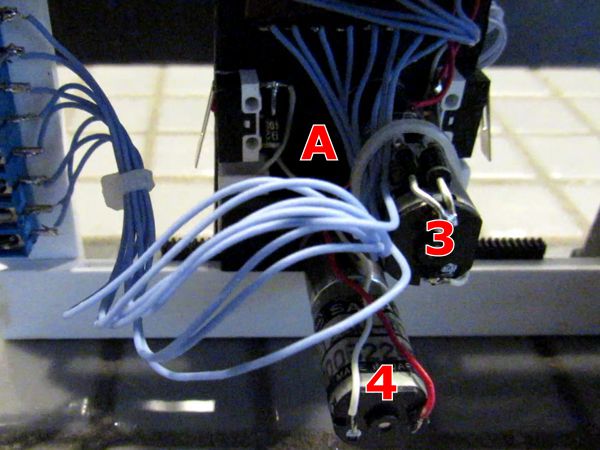Model Helicopter Flying
This wacky animation was literally born from a dream wherein I was flying an N Scale model of an RC model helicopter. After I woke up, I realized I just might be able to pull it off; it all hinged on being able to work with the finest tubing I had, which was stainless steel hypo tube, 0.010" OD, 0.005" ID. I also had some 0.004" diameter stainless music wire to pass through the tubing. The helicopter rotor, clipped from an etched brass part, was soldered to the wire, while the body was soldered to the hypo tube (below left). Beneath the diorama surface are four motors: rotor, elevation, rotation, and travel (see video).

1. 0.004" stainless steel music wire
2. etched brass scrap
3. tiny ball bearing
4. 0.010" OD, 0.005" ID stainless steel hypo tubing
5. slice of ~0.030" clear styrene rod
6. etched brass scrap
7. ~0.030" OD thin wall brass tubing
8. landing gear: see below
Making the landing gear (above right): etched brass fence cut at 1, 2 and 3, and bent 90 degrees at 4 to make U shape.

Above: the helicopter during construction. Below: the mosquito-sized finished model. I painted the copter white with a bright red stripe so as to make it more visible.

The mechanism is essentially two linear carriages, one nested inside the other. The larger outer carriage (A) moves the copter along its flight path. The smaller inner carriage (B) raises and lowers the copter; this carriage also provides the rotor spin and copter rotate functions.

There are four motors: (1) rotor spin; (2) rotate; (3) elevation; (4) travel.

Below is the finished scene; landing pads are yellow label material with targets printed with a laser printer. The lines of the targets are the width of the slots needed to allow the support hypo tube to move into their centers. The model helicopter flies on the Saturday at the Park diorama, with the slot for the support hypo tube hidden right behind the front rail of a short stretch of abandoned track.

|
|
|
|
